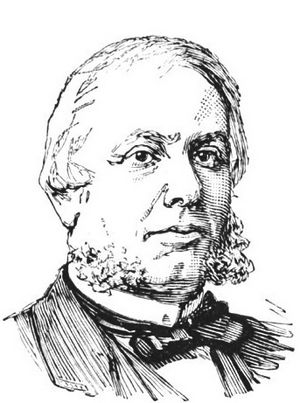Albert Ricot facts for kids
Albert-Augustin Ricot (born May 5, 1826 – died February 23, 1902) was a French civil engineer. He later became a successful factory owner, making iron products. He was also a politician who had his own ideas.
Contents
Early Life and Education
Albert was born in Paris. He was the third child of Jean François Emmanuel Constant Ricot and Marie Eugénie Renouard. His father, Jean, owned ships and was based in Saint-Valery-sur-Somme. This was a busy port for trade and fishing, north of Paris.
Albert grew up in a region called Picardy. He then went to a famous school in Paris, the School of Bridges and Roads. He studied to become a public civil engineer.
Building Roads and Tunnels
After school, Albert worked in the Vosges region, near Épinal. He worked on some important projects. One was the Bussang Tunnel. Another was an 18-kilometer (11-mile) road lined with plane trees.
This special road helped the emperor Napoleon III travel quickly and safely. He could go from the small train station at Aillevillers to a health resort called Plombières-les-Bains. In 1858, an important meeting happened there. The emperor and Count Cavour from Piedmont-Sardinia talked about how to unite Italy.
From Engineer to Iron Master
In Épinal, Albert Ricot met a talented young architect named Léon Grillot. Léon designed the church at Plombières. Later, he designed a chapel at Varigney for the empress.
Albert and Léon married two sisters, the daughters of Jérôme-Auguste Patret. Albert married Mélanie Pauline Nelly Patret on June 6, 1854. It was a double wedding, as Léon Grillot married her younger sister, Marie, at the same time.
Varigney was a place where iron had been made since the 1500s. Jérôme-Auguste Patret, Albert's father-in-law, ran the factory there. In 1860, Albert left his engineering job. He wanted to prepare to take over the factory. He became the boss in 1862 or 1863, after his father-in-law passed away.
By taking over this business, Albert Ricot became an important forge master. This meant he was in charge of a large iron-making factory.
Public Service and Politics
In 1863, Albert was chosen to be a local council member for the Vauvillers area. He worked hard to help the public. He was appointed to councils that worked on public education and public works. He also helped improve schools in Vesoul and Luxeuil. He kept his seat as a local council member until 1880.
Later, Albert also joined national politics. On February 8, 1871, he was elected to the National Assembly. This was the main law-making body in France. He represented the Haute-Saône region. He was part of a political group called Centre droit.
He was re-elected in 1876 and again in 1877. However, after the 1877 election was cancelled by the new parliament, he decided to leave politics for good.
Later Life
Albert Ricot passed away on February 23, 1902. He died in Dampierre-lès-Conflans, which is near Varigney.
Images for kids



